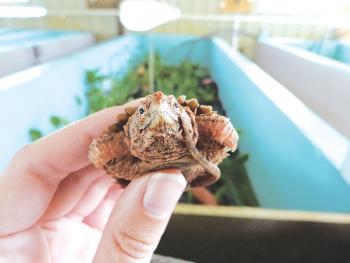Alligator snapping turtles released into wild
The Louisiana Department of Wildlife and Fisheries is working to ensure that future generations will be able to enjoy the recreational harvest of alligator snapping turtles by keeping the reptiles off the Endangered Species list.
“In the past, the alligator snapping turtle was a major target for commercial harvest,” said Amity Bass, Louisiana Department of Wildlife and Fisheries Natural Heritage program manager. “Now, the state only allows recreational harvest of one per person or per car per day. Some states don’t even allow recreational harvest anymore.
“We don’t want them to be listed. We want to keep the recreational harvest going, and other states want to too.”
A determination by the U.S. Fish and Wildlife Service of whether or not the animal will be added to the list is scheduled for 2017.
According to the department’s website, the turtle, America’s largest freshwater turtle, was once processed by the thousands each year in the state, and meat from the animal was used in turtle soups and gumbos. The department eventually placed a commercial size and recreational take limits on the turtles in 1993, and commercial harvest has banned in 2004.
In an effort to rehabilitate the alligator snapping turtle population, the department began raising turtles in 2012 through a head start program at its Monroe hatchery facility. The program is funded through a state wildlife grant.
“The hatchlings grow really fast, faster than in wild, because they are fed every day,” Bass said. “When they are released, they weigh 9 to 15 pounds. It may take many years to get to that size in the wild, maybe even 10 years depending on the environmental conditions.
“Their third year at the facility, they are moved to a pond stocked with bream where they can learn to fend for themselves.”
According to Bass, who studied the species while earning her master’s degree, the biggest problem facing the species is not the recreational harvest.
“There is a lack of juvenile recruitment,” she said. “We are seeing lots of older turtles and fewer younger turtles. There have been increases in raccoon and fire ant populations, and it is hard for all turtles to hatch and make it to water these days.”
The first batch of juvenile snapping turtles from the facility were released into the Calcasieu River at Sam Houston Jones State Park near Lake Charles earlier this summer. The animals were tagged and will be monitored for survival and to see if they reproduce at younger age than those growing up in the wild.
“The population in the Calcasieu River could use a boost,” Bass said. “Right now, we also have a trapper who is doing a statewide population survey to see where the population is looking good.”
“He is finished in the southeastern part of the state and he is making his way to the Red River and Atchafalaya River area to get population estimates in the central part of the state.”
- Log in to post comments

